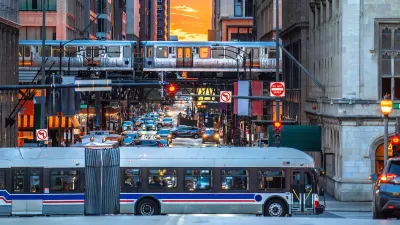Chicago's Fulton Market's new transit stop is attracting attention and investment in the neighborhood. Increasingly, more cities in the Midwest are embracing transportation projects as a means to revitalize downtowns and historic districts.
Midwestern cities are convinced of the value of transit for helping to revitalize neighborhoods, writes Ian Fullerton. Real estate developers and city planners alike recognize that improved access often means improves opportunities for economic activity.
"It's no coincidence that the streetcar's backers are the same ones rebuilding the city’s downtown. 'In the case of the Woodward corridor and M-1 light rail [in Detroit], we have the rare combination that the developers of the system are also creating the development that will generate the riders,' said Richard Carlisle, president of Ann Arbor-based development planning consultant firm Carlisle/Wortman Associates and a supporter of the project."
"Other cities across the Midwest have followed suit with transportation projects that aim to connect neighborhoods within urban environments, as opposed to the commuter systems that shuttle people directly to the suburbs. In Cincinnati, where streetcars were once a main mode of transportation, planners expect to start running new downtown cars by 2016. Cleveland’s 'HealthLine' Bus Rapid Transit system—leading from the city’s Public Square to the university- and hospital-heavy East Cleveland neighborhood—has been hailed as a public transit success story and an economic motivator, earning credit for more than $4.3 billion in development along the city’s Euclid Avenue Corridor since opening in 2008."
FULL STORY: Urban Reroute

Study: Maui’s Plan to Convert Vacation Rentals to Long-Term Housing Could Cause Nearly $1 Billion Economic Loss
The plan would reduce visitor accommodation by 25,% resulting in 1,900 jobs lost.

North Texas Transit Leaders Tout Benefits of TOD for Growing Region
At a summit focused on transit-oriented development, policymakers discussed how North Texas’ expanded light rail system can serve as a tool for economic growth.

Why Should We Subsidize Public Transportation?
Many public transit agencies face financial stress due to rising costs, declining fare revenue, and declining subsidies. Transit advocates must provide a strong business case for increasing public transit funding.

How to Make US Trains Faster
Changes to boarding platforms and a switch to electric trains could improve U.S. passenger rail service without the added cost of high-speed rail.

Columbia’s Revitalized ‘Loop’ Is a Hub for Local Entrepreneurs
A focus on small businesses is helping a commercial corridor in Columbia, Missouri thrive.

Invasive Insect Threatens Minnesota’s Ash Forests
The Emerald Ash Borer is a rapidly spreading invasive pest threatening Minnesota’s ash trees, and homeowners are encouraged to plant diverse replacement species, avoid moving ash firewood, and monitor for signs of infestation.
Urban Design for Planners 1: Software Tools
This six-course series explores essential urban design concepts using open source software and equips planners with the tools they need to participate fully in the urban design process.
Planning for Universal Design
Learn the tools for implementing Universal Design in planning regulations.
City of Santa Clarita
Ascent Environmental
Institute for Housing and Urban Development Studies (IHS)
City of Grandview
Harvard GSD Executive Education
Toledo-Lucas County Plan Commissions
Salt Lake City
NYU Wagner Graduate School of Public Service




























